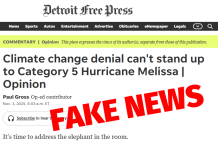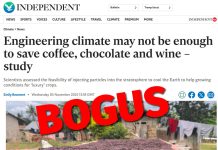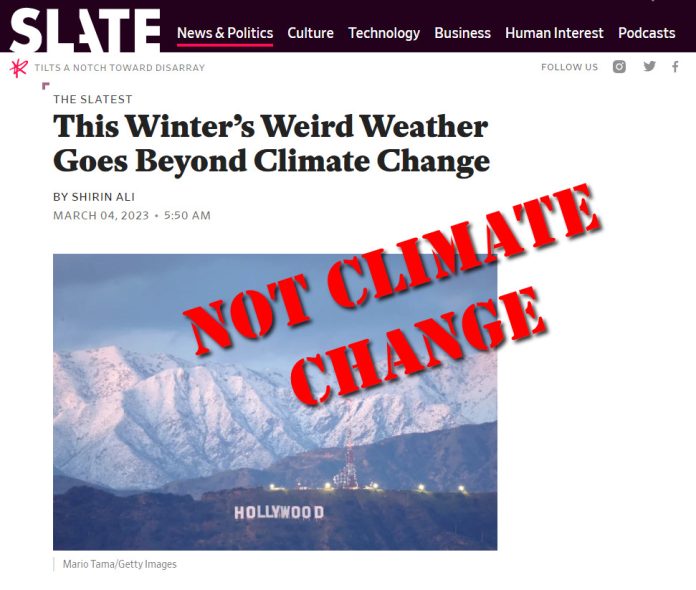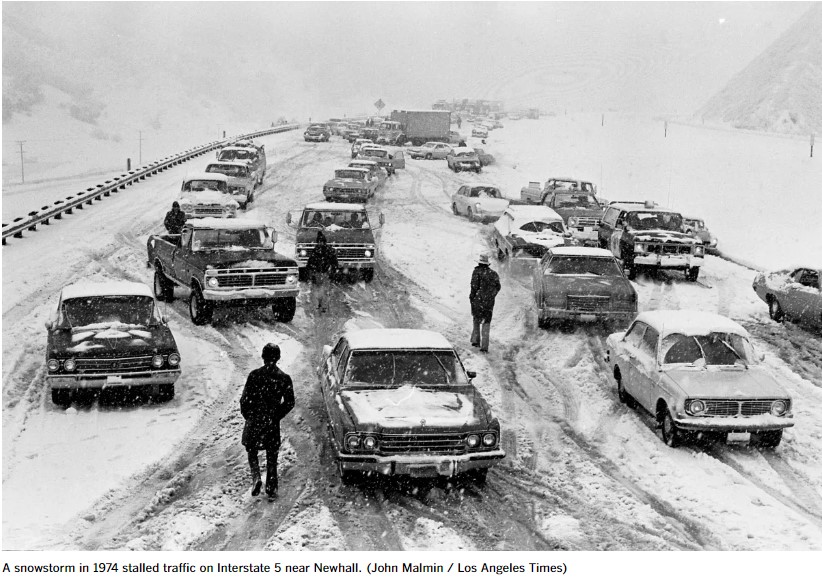An article in Slate suggests that the fact that some locations have experienced winter weather events this year that are unusual for them, is evidence climate change is causing weird weather. This is false. Every year different places around the globe experience atypical weather, they always have. Unusual weather events have never occurred in predictable patterns, and there is no evidence during the recent period of modest climate change, that extreme weather events are becoming less predictable or weirder, or increasing in frequency.
In the article, This Winter’s Weird Weather Goes Beyond Climate Change, associate writer Shirin Ali, makes several errors by using leaps of logic that renders the entire article completely false.
First, the article contradicts its own headline in the beginning paragraphs:
This winter season has thrown some wild weather our way, from winter storm Elliott to the arctic airmass that consumed New York, and now a major snowstorm is simultaneously hitting the Northeast and California. Climate researchers generally agree this is not normal. So, what’s causing it? Researchers are actively trying to answer that and it’s proving to be complicated.
Global warming may sound like the obvious answer, but it’s not that simple, since the climate naturally operates with a degree of random variability that can also produce strange weather patterns every so often.
In one paragraph, Ali admits that the reasons for unusual weather events are complicated and that researchers are “searching for answers,” only to then in the very next paragraph, suggest climate change is the cause of weather variability. Its not, weather is naturally variable.
Ali obviously doesn’t understand the difference between weather and climate. Yet, as discussed in Climate at a Glance: Weather vs. Climate, the difference between weather and climate is clearly defined.
The World Meteorological Organization (WMO) defines climate as “…the average weather conditions for a particular location and over a long period of time.” To create a climate record, 30 years of weather data is averaged to create a “normal” climate expectation for a location or region. What we experience on a day-to-day basis are weather events, not climate events. Weather is not climate.
Ali goes on to talk about increased variability of weather due to “…two opposing natural cycles; La Niña, a cool phase, and El Niño, a warm phase.” In that she is correct, these natural patterns in the Pacific Ocean are highly influential on weather, but they don’t represent climate patterns or trends. Either oceanic trend can span anywhere from 1 to 4 years, far short of 30 years needed establish a climate trend.
Ali has missed the fact that in the past few months, the Pacific Ocean has been transitioning from the La Niña cool phase to the El Niño warm phase. During such a transition, weather is even more variable than usual because neither phase is dominant. That alone can explain the weather events deemed “weird” by Ali.
Ali also misunderstands the nature and history of the weather phenomenon known as “The Polar Vortex,” which she also wrongly links to global warming by suggesting a “disrupted polar vortex” is a result of climate change.
“This year’s disrupted polar vortex was the fourth such event in the last six years, which NOAA says is rare and hasn’t been seen ‘over more than six decades of stratospheric observations,’” writes Ali.
Actual facts are covered in Climate at a Glance: The Polar Vortex:
The phrase “polar vortex” is often erroneously used by the media to link climate change and severe winter weather events. The polar vortex was first identified as a cause for some instances of severe winter weather events in 1853. Claims that climate change is creating new and more severe polar vortex events are not supported by either observational evidence or computer climate models.
The photo accompanying the Slate headline shows snow in the Los Angeles hills with the Hollywood sign, with the headline suggesting this is weirdly abnormal. A simple check of weather history shows such snow events, while hardly yearly occurrences, have been fairly common.
The Los Angeles Times ran an article a few days earlier with the headline: Snowballs at the Hollywood sign: Does it signal the biggest SoCal snow event in decades? In that article, the Times provides a picture from 1974 of another big snowstorm, one even bigger than this most recent one.
The article chronicles a number of Los Angeles snowfall events in recent history:
Snow also made appearances in 2019, 2007, 1998, 1987 and 1974, according to Times archives. In 1962, heavy snow fell in the mountains and high deserts and dusted parts of downtown and West Los Angeles before melting quickly.
Perhaps the most famous snowstorm was in January 1949, when several inches piled up in the region over several days. Times articles from that time described 14 inches of snow on Ventura Boulevard near Woodland Hills, a foot in Laurel Canyon and light flurries around the L.A. Civic Center.
In fact, according to the document, “A History of Significant Weather Events in Southern California,” snow in Los Angeles has been officially recorded as far back as 1847 when records began, as seen below.
Note in 1848, “Several thousand head of cattle were destroyed.” Presumably due to the deep snow and cold. Climate change wasn’t even on anyone’s radar back in 1848, much less in 1974 when the big snowstorm snarled traffic on Interstate 5, as seen in the photo above.
Obviously, such weather events have occurred periodically throughout in Southern California’s weather history. They seem “weird” only to people who ignore history, or who have short memories, or who believe pushing political action to prevent a purported climate crisis, justifies ignoring facts. Based on her Slate story, Ali seems to fall into one or more of those categories.
Without checking history or facts, Slate published a totally erroneous and misleading story, which speaks to the trend of journalism today being more about climate advocacy than it is about reporting the truth about climate.

























THE COMBINATION OF THE LARGE HUMID AND SALINE MASS OF THE “HUNGA TONGA…” VOLCANO LAUNCHED IN THE GREAT ERUPTION OF LAST JANUARY 2022 AT MORE THAN 50 KM ALTITUDE, WAS APPROXIMATELY MORE THAN 12% TO 14% OF HUMIDITY WHAT OUR ATMOSPHERE CONTAINS AT THOSE HEIGHTS. THE MULTIPLE METEO-CLIMATIC INTERACTIONS ARE THE ORIGIN OF THE MULTIPLE PHENOMENA OF EXTREMELY COLD AND PROLONGED HEAT FROM THE LAST YEAR UNTIL NOW AND WILL CONTINUE TO OCCUR IN THE NEXT FIVE YEARS APPROXIMATELY UNTIL THE PREVIOUS NORMAL LEVELS OF WATER VAPOR RETURN TO THOSE HEIGHTS OF MORE THAN 50 km. THESE SITUATIONS OF CAUSES AND EFFECTS SHOULD BE BETTER STUDYED NOW, GIVEN THE EXTRAORDINARY SITUATION THAT CAUSED THE VOLCANIC ERUPTION OF JANUARY 2022, IT IS TIME TO STUDY IT WELL AND CORRECTLY TOGETHER. OK???.
A VERY CORDIAL GREETING TO ALL.
ANTHONY LOPEZ. (alzheimercartagenaycomarca@gmail.com).-